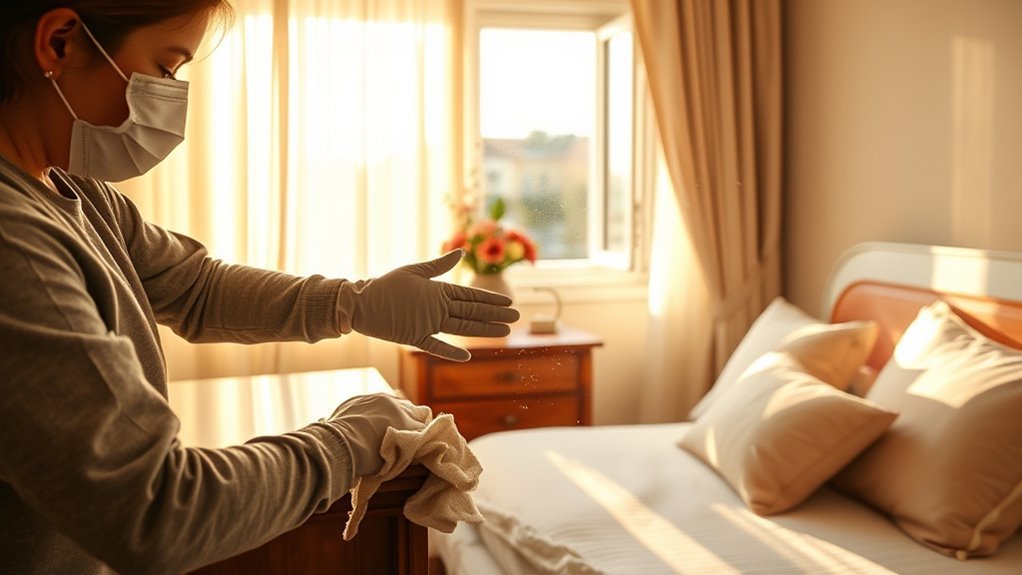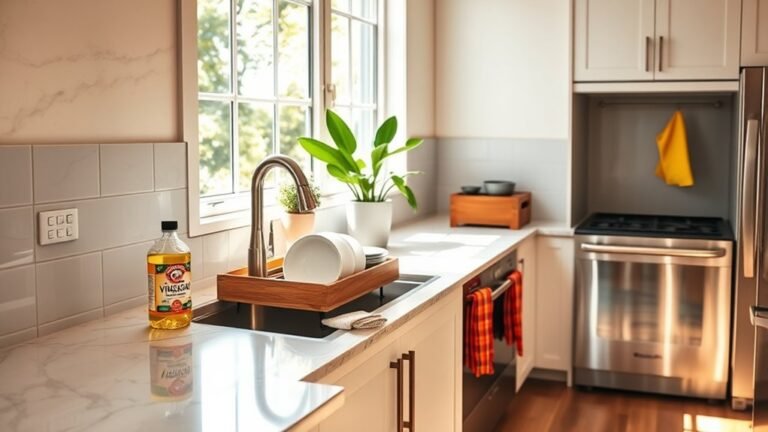How to Clean Your Bedroom Safely
To clean your bedroom safely, start by gathering eco-friendly supplies like microfiber cloths and plant-based cleaners. Declutter to clear surfaces for easier dusting, using slightly damp cloths to trap dust without scattering allergens. Vacuum carpets carefully and mop floors with gentle solutions, avoiding excess water. Protect yourself with gloves and guarantee proper ventilation. Handle electronics with dry cloths and store cleaners securely out of reach. Following these steps will set a strong foundation for a healthier, more comfortable space—and there’s more to explore on maintaining your bedroom’s cleanliness.
Gather the Right Cleaning Supplies

Before you begin cleaning your bedroom, it’s essential to gather the right supplies to make the process efficient and safe. Start by selecting important cleaning tools such as microfiber cloths, a soft-bristled broom, a vacuum with HEPA filters, and a sturdy dustpan. Opt for eco friendly supplies like plant-based all-purpose cleaners, natural disinfectants, and reusable mop pads to minimize environmental impact and avoid harmful chemicals. Having these ready guarantees you’ll tackle dust, allergens, and stains effectively without compromising your health or freedom from toxins. Organizing your supplies beforehand streamlines your workflow, letting you move confidently from one task to the next. By choosing sustainable, safe products, you protect both your personal space and the planet, empowering you to maintain a clean, healthy bedroom.
Declutter Before You Clean
Although it might be tempting to dive straight into dusting and vacuuming, you’ll find the process much smoother if you start by decluttering your bedroom. Begin by sorting through your belongings with intention: keep only what you need or love, and set aside items to donate or discard. This helps minimize clutter, making cleaning more efficient and your space more serene. As you organize belongings, designate specific spots for each category—clothes, books, accessories—to maintain order long-term. Clear surfaces and floors, allowing you to access every corner when you clean. By methodically reducing excess and organizing thoughtfully, you not only create a safer, cleaner environment but also reclaim freedom from chaos, turning your bedroom into a restful sanctuary where cleaning becomes less of a chore.
Dust Surfaces Safely

Once you’ve cleared your bedroom of clutter, you can focus on dusting surfaces safely to protect both your health and your belongings. Start by selecting safe dusting tools like microfiber cloths or electrostatic dusters, which trap dust instead of scattering it. Avoid dry dusting, as it can send particles into the air, affecting your breathing. Instead, lightly dampen your cloth to capture dust more effectively. Use gentle, deliberate dust removal techniques—work from higher surfaces downward to prevent re-contamination. Pay close attention to hidden areas such as window sills, shelves, and ceiling fans. Make sure to wash or replace your dusting tools regularly to avoid redistributing allergens. With these methodical steps, you maintain a cleaner, healthier space, giving you the freedom to breathe easy in your revitalized bedroom.
Vacuum and Mop Floors Properly
After carefully dusting surfaces to keep allergens at bay, it’s time to focus on your floors, which often collect the most dirt and debris. Start by selecting the right vacuum setting based on your carpet types—use a higher pile setting for shag rugs, and a lower one for short-pile carpets to avoid damage. For hard floor materials like hardwood, tile, or laminate, switch to a vacuum without a beater bar to prevent scratches. Once vacuumed, mop your floors using a cleaner appropriate to the material; for instance, use a damp mop with a gentle solution on hardwood, avoiding excess water that can warp the wood. This methodical approach guarantees thorough cleaning without compromising your floor’s integrity, giving you freedom to enjoy a fresh, safe bedroom environment.
Wash Bedding and Curtains Regularly

Because bedding and curtains trap dust, allergens, and skin cells, washing them regularly is essential for maintaining a healthy bedroom environment. For effective bedding care, strip your sheets, pillowcases, and blankets at least once a week. Use warm water and a suitable detergent to eliminate allergens thoroughly. Don’t forget to check care labels to avoid damage. Similarly, curtain cleaning should be part of your routine every few months. Remove curtains carefully and wash them according to fabric type—some can go in the machine, while delicate fabrics may require hand washing or dry cleaning. Regular washing prevents buildup that can aggravate allergies and keeps your space fresh. By staying consistent with these tasks, you’ll foster a freer, cleaner bedroom atmosphere that supports your well-being.
Use Non-Toxic Cleaning Products
Keeping your bedding and curtains free from dust and allergens is an important step, but the cleaning products you choose play a significant role in maintaining a safe bedroom environment. Opt for eco friendly alternatives to conventional cleaners that often contain harsh chemicals. These alternatives reduce airborne toxins and minimize skin irritation risks. You can also create homemade cleaners using simple ingredients like vinegar, baking soda, and lemon juice, which are effective and non-toxic. When tackling surfaces, spray your eco friendly cleaner evenly, let it sit briefly, then wipe thoroughly to remove dirt without leaving harmful residues. By choosing these safer options, you protect your health and preserve your bedroom’s air quality, empowering you to enjoy a fresh, clean space without compromising your well-being.
Protect Yourself With Gloves and Masks
Wearing gloves and masks during bedroom cleaning is one of the simplest yet most effective ways to protect yourself from dust, allergens, and chemical exposure. By using proper protective gear, you maintain your health while gaining the freedom to clean thoroughly without worry. Follow these hygiene practices to guarantee safety:
Gloves and masks are essential for safe, thorough bedroom cleaning, shielding you from dust and chemicals.
- Choose disposable gloves that fit well to avoid tearing and contamination.
- Wear a mask rated for dust and chemical particles to prevent inhalation of irritants.
- Replace gloves and masks after each cleaning session to maintain hygiene.
- Wash your hands immediately after removing gloves to eliminate any residual contaminants.
These steps form a methodical approach to safeguarding your well-being, letting you clean confidently and freely.
Ensure Proper Ventilation While Cleaning
Although gloves and masks protect you from direct contact with dust and chemicals, ensuring proper ventilation is equally essential to minimize airborne irritants during bedroom cleaning. You should open windows and doors to enhance air circulation, allowing fresh air to replace stale, contaminated air. If possible, use a fan to direct dust particles outside, improving air flow further. Proper ventilation reduces the risk of respiratory irritation and creates a safer, more comfortable cleaning environment.
| Ventilation Method | Benefit |
|---|---|
| Open windows | Introduces fresh air |
| Use fans | Enhances air circulation |
| Keep door open | Prevents buildup of fumes |
Handle Electrical Items Carefully
Before you start cleaning any electrical items, make sure to unplug them to eliminate the risk of electric shock. Always use a dry cloth when wiping surfaces to prevent moisture from damaging the components or causing short circuits. Taking these precautions will help you maintain your devices safely and effectively.
Unplug Before Cleaning
Since electrical items pose a risk when handled improperly, you should always unplug them before cleaning. Prioritizing electrical safety helps prevent shocks, short circuits, and damage to your devices. To maintain proper safety precautions, follow these steps:
- Locate the plug and firmly grasp it—never pull by the cord.
- Confirm your hands are dry to avoid electric shock.
- Unplug all devices in your bedroom, especially lamps, chargers, and alarm clocks.
- Wait a few minutes before cleaning to allow any residual current to dissipate.
Use Dry Cloths Only
One essential rule to remember when cleaning electrical items is to use dry cloths only. Moisture can easily seep into sensitive components, causing damage or short circuits. By choosing dry cloths, you harness the dry cloth benefits: they pick up dust without introducing any risk of moisture-related harm. Avoiding moisture is vital because even a tiny drop can compromise your devices or create a safety hazard. When you clean, gently wipe surfaces with a soft, lint-free dry cloth, ensuring you don’t press too hard or let any dampness sneak in. This careful approach preserves your electronics and offers you freedom from worry about accidental damage. Trust in dry cloths to keep your bedroom’s electrical items clean and safe every time.
Store Cleaning Materials Securely
Although cleaning materials are essential for maintaining a tidy bedroom, storing them securely is just as important to guarantee safety and prevent accidents. Proper cleaning storage not only protects you but also preserves the effectiveness of your supplies. To ensure material safety, follow these steps:
- Keep all cleaning products in a locked cabinet or high shelf, out of reach of children and pets.
- Store chemicals separately to avoid dangerous reactions.
- Use original containers with clear labels to prevent misuse.
- Avoid storing materials near heat sources or direct sunlight to maintain their integrity.
Frequently Asked Questions
How Often Should I Deep Clean My Bedroom?
You should set your bedroom frequency for deep cleaning at least every three months to maintain a fresh, healthy space. Sticking to a consistent cleaning schedule helps prevent dust buildup and allergens, giving you freedom from frequent, overwhelming chores. Depending on your lifestyle and allergies, you might adjust this to every two months. Being methodical with your schedule guarantees your bedroom feels inviting and supports your well-being without restricting your time.
What’S the Best Way to Remove Mold From Bedroom Walls?
You might think mold removal is complicated, but it doesn’t have to be. First, wear gloves and a mask to protect yourself. Mix a solution of one part bleach to three parts water for effective wall treatment. Gently scrub the moldy area with a sponge, then let it dry completely. Verify your room is well-ventilated during this process to prevent mold’s return. Regularly check for leaks to maintain a mold-free freedom in your space.
Can I Use Essential Oils to Freshen My Bedroom Air?
You can definitely use essential oils to freshen your bedroom air, and they’re a natural alternative to chemical air fresheners. Just add a few drops to a diffuser or mix with water in a spray bottle for a gentle mist. Be mindful of allergies or sensitivities, and never apply oils directly to skin or furniture. This method lets you enjoy fresh, personalized scents while maintaining a healthy, breathable space.
How Do I Clean Pet Hair From Upholstery Effectively?
To clean pet hair from upholstery effectively, start with regular pet grooming to reduce shedding. Then, use vacuuming techniques like a handheld vacuum with a brush attachment to lift hair from fabric fibers. Work methodically in one direction, covering all areas. For stubborn hair, dampen a rubber glove and rub the surface; the hair will clump up for easy removal. These steps free your upholstery from pet hair efficiently and thoroughly.
What’S the Safest Way to Get Rid of Bed Bugs?
To get rid of bed bugs safely, you’ll want to start with thorough bed bug prevention: wash bedding in hot water and vacuum regularly. For effective treatments, use a combination of heat treatments, insecticides labeled for bed bugs, and encase mattresses in protective covers. Be methodical—inspect cracks and crevices, and repeat treatments as needed. Taking these steps helps you reclaim your space without harmful chemicals, giving you the freedom to sleep soundly again.






